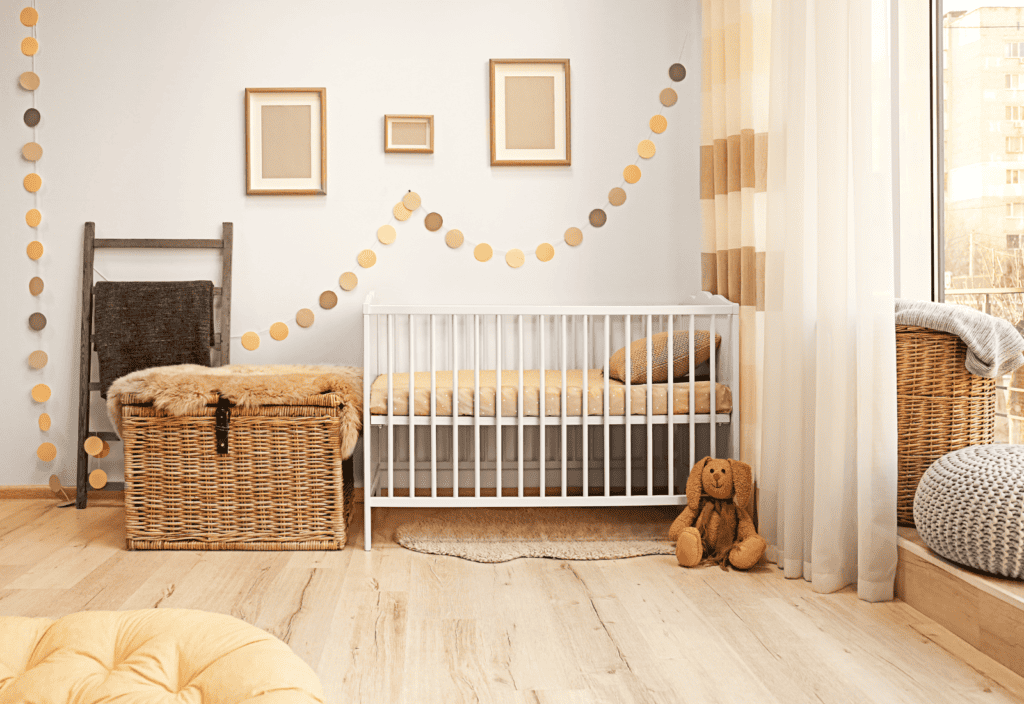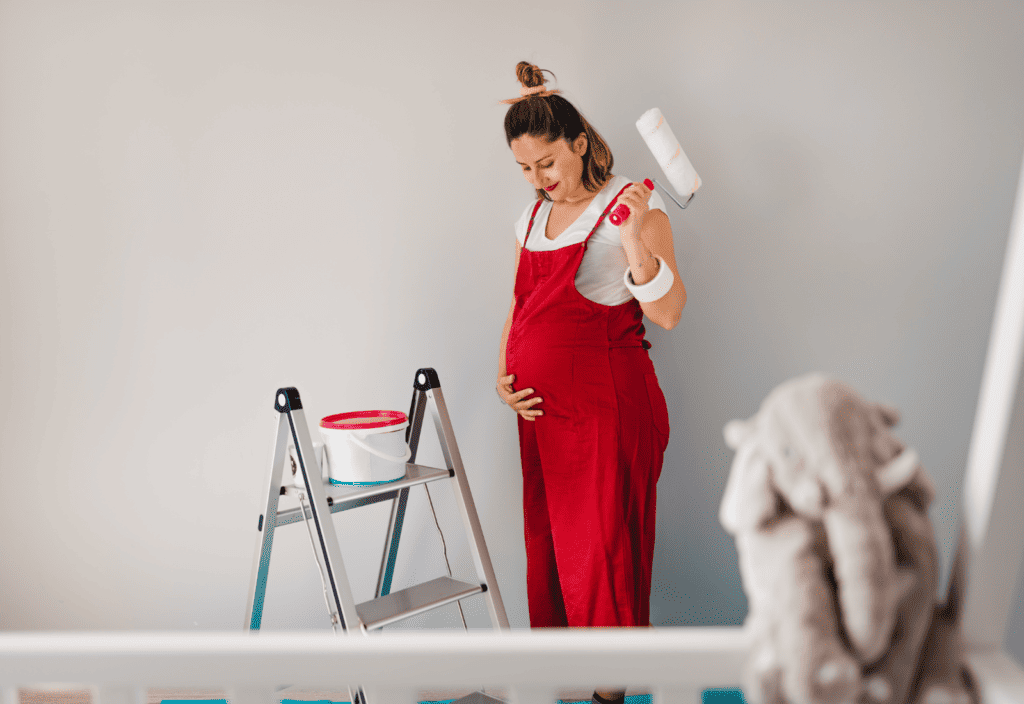Painting your nursery is a special time in your life. You don’t want to worry about the toxins lingering on the walls and in your air. Let’s check out some baby safe paint that is zero VOC (and more), making it safer for mom to be and baby too.

What are VOCs?
The acronym VOC stands for volatile organic compounds. According to the EPA, VOCs are compounds that have a high vapor pressure and low water solubility. These tend to be man-made chemicals that are used and produced in the manufacture of paints, pharmaceuticals and refrigerants. VOCs are much higher indoors than outdoors even if you live in a big city.
VOCs are often accompanied with a strong scent like “new car smell,” for example. Yes, some people love new car smell, but once you realize it’s the biproduct of off gassing materials it kind of loses its appeal. Think new furniture, freshly finished hardwood floors and so on.
VOCs negatively impact your indoor air quality, which can affect every organ in your body not just your lungs. They are linked to a number of short-term conditions like dizziness, headaches and fatigue as well as long-term conditions like kidney, liver or nervous system damage.
One of the best-known VOCs in paint is formaldehyde. Trace amounts of formaldehyde are added to paint to stop bacterial and fungal growth, which is understandable in a bathroom for example but maybe not necessary in a nursery.
Let’s take a look at how paint is regulated and what certifications it can earn.
Paint Rating Systems and Certifications
EPA Method 24
This is a common and the only EPA accepted method for testing paints, finishes and similar. This method of testing is known to contain some errors and blind spots. It excludes a number of harmful compounds.
ASTM-D4236
ASTM-D4236 is a standard used to ensure safety art supplies sold in the U.S. It simply means that all potentially hazardous components of the product have been clearly labeled on the product packaging. This is not a requirement for wall paint, but there are a few paints that meet this standard.

Greenguard and Greenguard Gold Certifications
There are several different UL Greenguard certifications. The basic Greenguard allows a VOC emission rate of 500 ug/m3 while Greenguard Gold allows a VOC emission rate of 220 ug/m3. The most stringent is the Greenguard Formaldehyde-Free Certification.
To earn this certification, a product must meet the Greenguard Gold requirements and also have a very, very low formaldehyde emission. The Environmental Working Group (EWG) recommends paint with the Greenguard Gold certification.
Green Seal
Green Seal has been around since 1993, and their label (specifically the Green Seal 11 certification) is recommended by the Environmental Working Group (EWG). They offer certifications in different categories including medical equipment, building materials and finishes, furniture and cleaning products.
Their standards ensure that products are low VOC and low emissions in order to protect air quality. Now, that we’ve covered the potential certifications, let’s take a look at some of the most trustworthy baby safe paints available.
Safest Paints on the Market
Each year, more and more paint companies lower the VOCs in their formulas making baby safe paint a little easier to find. While all paint still contains some toxins, choosing zero VOC paint, ventilating the room and utilizing an air purifier can make painting much safer.
ECOS Paints
I first heard about ECOS Paints on a baby blog long before I became a blogger. ECOS Paints is well known within the clean-living community. ECOS Paints conforms to ASTM-D4236 and is zero VOC. They use 1-hydroxy-2-pyridinethione as a preservative which is a safer preservative.
They offer a wide range of paints as well as a color match system on their website. Let me warn you that this safety comes at a price. A gallon of paint is about 3x the cost of what you would normally grab at Lowe’s.
If ECOS is within reach for you, go for it as it’s definitely one of the safest paints on the market today.
AFM Safecoat
AFM Safecoat has a similar safety profile to ECOs. Safecoat is zero VOC and contains no extenders, drying agents, formaldehyde, mildewcides or fungicides. These are those “other toxins” we talked about above that linger in your air for years.

Safecoat claims their primer is superior and guarantee you will only need one coat. The primer is low VOC rather than zero VOC. One downside to this brand is that you have to place an order from a supplier. You can look up the supplier nearest you on their website.
Clare Paint
Clare paint is zero VOC and Greenguard gold certified. You can order the paint directly from their website. It will run you $64/gallon and they offer $2 stick on swatches. Reviewers really seem to love this paint and rave about how smooth it goes on.
I believe Clare paint probably does contain some type of antifungals or other toxins simply because the website doesn’t state otherwise. When you reach out to customer service, they aren’t forthcoming on additional details.
If I learn more about their formula, I will update this post. It’s still a clean paint in the grand scheme of things, but I don’t think their formula is as clean as ECOS or AFM Safecoat.
Benjamin Moore Eco Spec
Eco Spec contains zero VOCs and zero emissions. It is tinted with Benjamin Moore’s proprietary Gennex zero VOC colorant system. It is Green Seal Certified as well as certified asthma and allergy friendly. You can view the full ingredient list here.
Eco Spec is the cleanest Benjamin Moore paint with Aura being next in line. The nice thing about Benjamin Moore paints is that they are widely available unlike some of these brands, which take a little more time and effort to get.
Other Zero VOC Paints
Well-known brands like Sherwin-Williams, Behr and Valspar now all carry zero VOC paints. While I attempted to select the absolute cleanest baby safe paint, any zero VOC or very low VOC paint is better than one that’s not. Valspar, which is Lowe’s store brand, is a nice budget-friendly option that I have used several times.
Safe Painting Tips
Regardless of what paint you choose, the first days on and after painting produce the most off gassing. When a paint says its zero VOC, this is not until after 14 days … that information is new to me.

It is beneficial to leave your home for hours or even days if you can or open windows and/or use an air purifier to clean your home’s air. If you are expecting, consider letting your hubby or someone else take the job of painting the nursery.
If you are painting furniture rather than walls, complete the job outside then leave the item in the garage to off gas if you don’t need it right away. Be sure to check out my related post on non-toxic chalk paint if you enjoy refurbishing furniture.
Conclusion
Thanks to advances in technology the selection of baby safe paint is larger than ever with many zero VOC (and beyond) options to choose from. I hope this post helps you find a paint that you are comfortable using in your nursery or entire home.
Oh, and best of luck finding that perfect color—that’s an entirely different blog post ;).